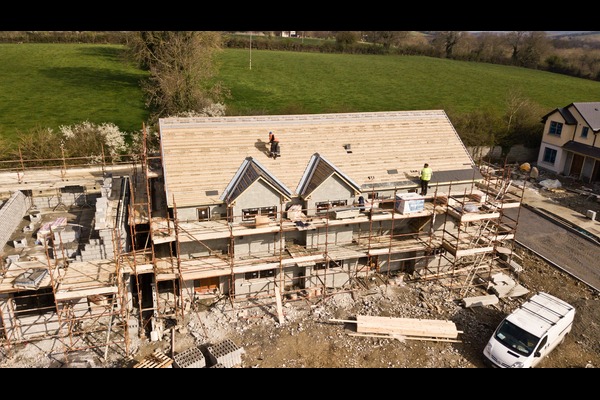These Easy DIY Changes Could Add £30,000 to your Home’s Value
Adding big money to the value of your home does not have to mean spending big money on big changes. Major structural alterations and extensions are all well and good, though they are beyond the realm of possibility for most.
Making the most of your home’s potential without going to extremes is all about focusing on what matters most too prospective buyers. Get it right, and some real estate experts suggest you could add up to £30,000 to the value of your home.
In particular, there are three simple yet effective modifications to focus on, which collectively can make a huge difference.
Strategic painting
Ask any home staging specialist, and they will tell you the same: painting all of your interiors in neutral colours is the way to go. It is always advisable to create something like a blank canvas, upon which prospective buyers can visualise their own ideal interiors.
Of equal importance is making sure your front door and porch/entrance are in flawless condition. A fresh coat of paint is essential to giving the best possible first impression.
Incredibly, a study carried out by Sellhousefast.uk found that a beautifully painted blue front door alone can add up to £4,000 to the value of a property. Pops of colour like these can work a treat, perfectly complementing the neutral interiors within.
Pristine presentation outdoors
Be mindful of the fact that more prospective buyers than ever before are focusing heavily on gardens and outdoor living spaces. With the painful memories of lockdown still firmly in the minds of most, the freedom to relax and unwind outdoors at home is becoming a top priority.
This means doing whatever it takes to get your gardens, patios, decking, and so on in order. It also means arranging viewings at the right time of day, when your outdoor spaces are basking in beautiful sunshine.
Weed your garden, mow the lawn, and make the whole thing as presentable as you possibly can. Repair or remove anything that isn’t in ideal condition, and prominently present comfortable seating and outdoor dining furniture.
De-clutter intensively
Last but not least, comprehensive decluttering is essential, indoors and out, with the intention of presenting your home as something of a blank canvas for would-be buyers.
The more clutter you have about the place, the more difficult it becomes for visitors to picture themselves living there. They are more likely to focus on your chintz and trinkets than your home and its interiors in general.
If necessary, fork out for a self-storage unit for a few weeks and remove everything that does not need to be there. A small price to pay will improve both the appeal and the potential market value of your home.
Finance Options for Buying an Uninhabitable Property
Most major banks and high street lenders are unwilling to finance the purchase of uninhabitable properties, which is unfortunate given how investors and other home buyers often set their sights on “fixer-uppers.”
Properties in a poor state of repair often sell for less than their true potential market values, so what types of financing options are available for purchasing uninhabitable properties?
Uninhabitable properties defined
Different lenders have their own unique interpretations of what “uninhabitable” means.
Most will exclusively, however, lend against properties that:
- Are in a good state of general repair.
- Can be considered safe to inhabit in their current condition.
- Have a functional bathroom and kitchen.
- Are secure and in structurally sound condition.
- Have reliable electricity and a central heating system.
- Do not have issues with infestations.
It is not uncommon for the opinions and perspectives of prospective buyers to differ from those of the lender. What you consider to be a perfectly viable property with huge investment potential may be viewed as a major risk and therefore unacceptable by a conventional bank.
Securing the finance needed may mean setting your sights away from the High Street and considering the alternative options available.
Traditional loan alternatives for an uninhabitable property
When a traditional property loan or mortgage is out of the question, a bridging loan represents an accessible and affordable alternative, particularly when it comes to the purchase and subsequent renovation of uninhabitable properties.
With bridging finance, the vast majority of established lenders are willing to lend against a wide variety of property types, including those considered uninhabitable. Unlike a mortgage, a bridging loan is typically repaid within a period of one to 18 months, often when the renovations have been completed and the property has been sold or transferred on to a longer-term mortgage product.
One of the most appealing aspects of bridging finance is that when the funds borrowed are repaid promptly, overall borrowing costs can be highly competitive. Often charged at less than 0.5% per month, a short-term bridging loan can be exponentially more affordable than a conventional mortgage.
How is bridging loan eligibility determined?
Eligibility for a bridging loan is assessed primarily on the viability of the property used to secure the loan. Additional factors such as income level, financial status, and credit history may be taken into account, though these are typically secondary considerations.
Importantly, applicants are expected to have an acceptable ‘exit strategy’ in place. This means providing evidence as to how and when they intend to repay the loan, such as when the renovations are complete and the property is subsequently sold.
Bridging finance can also be useful in time-critical situations, such as when looking to purchase a property at auction. Depending on your requirements and the strength of your application, it is possible to secure the funds you need within a matter of days.
For more information on any of the above or to discuss finance options for purchasing uninhabitable properties in more detail, contact a member of the team today.
How Do Bridging Loans Work for First-Time Buyers?
It is often assumed that bridging finance is a facility restricted exclusively to existing homeowners; however, bridging loans can also be surprisingly flexible, accessible, and affordable options for first-time buyers.
Eligibility for bridging finance is assessed primarily on the borrower’s ability to provide acceptable security for the loan. If you have fixed assets, such as commercial property, residential property, or land, with a combined value that covers the costs of the loan, it is of no consequence whether you currently own a residential property.
When would a first-time buyer consider bridging finance?
Bridging loans differ from conventional mortgages in that they are designed to be repaid in full within a term of between 1 and 18 months. In addition, the funds can be made available within a matter of days, and after the first month, interest is charged on either a monthly or daily basis, typically less than 0.5% per month.
A bridging loan for a property purchase (when repaid promptly) can work out exponentially more cost-effectively than a long-term mortgage.
First-time buyers may consider bridging finance for several scenarios, including:
- To purchase a property at auction at a bargain price
- To buy a non-standard property that major lenders would refuse
- To purchase a ‘fixer-upper’ to subsequently sell at a profit
- To avoid the costs and binding obligations of a mortgage
Where a property is purchased by way of bridging finance, the loan can subsequently be repaid by taking out a conventional mortgage, raising the funds elsewhere, or selling.
How is first-time buyer bridging finance eligibility assessed?
For the most part, bridging finance specialists are primarily interested in the applicant’s ability to cover the costs of the loan with appropriate security. Most lenders exclusively accept residential and commercial properties and land as security.
A check on credit history may also be necessary, in accordance with the chosen lender.
Most important is proof of a viable exit strategy. This means providing the lender with a full disclosure of when and how you intend to repay the loan. For example, by selling the property you purchased and generating a profit,
How much can a first-time buyer borrow?
There are technically no limitations as to how much any applicant can borrow; it all depends on the value of the assets you offer to secure the loan. In most instances, however, bridging finance for property purchase transactions is available for up to 75/80% of the value of the property, depending on the individual circumstances of the applicant.
In all instances, it is advisable to consult with an independent broker at the earliest possible stage in order to ensure you get the best deal. Competitiveness varies enormously from one bridging loan specialist to the next, so it is important to conduct a thorough market search before deciding who to do business with.
For more information on any of the above or to discuss bridging loan applications in more detail, contact a member of the team at Bridgingloans.co.uk today.
Bridging Loan Popularity Soaring Among Senior Borrowers
Bridging finance has been growing in popularity across the UK for some time. But what is particularly interesting is how more senior borrowers (of retirement age and older) are taking an interest in bridging loans than ever before.
Despite the fact that seniors are considered more financially savvy and asset-rich than their younger counterparts, they are often rejected by major lenders for even the simplest financial products. The reason is that, as their long-term earning potential is lower and they may have no formal proof of income, they fail to meet the most basic checks carried out by mainstream lenders.
As a viable and cost-effective alternative, short-term lending is attracting the attention of seniors in record numbers. Issued primarily or exclusively on the basis of security, short-term loans like bridging finance can be quicker, easier, and less stressful to arrange.
Popular uses for bridging finance
Seniors (and those over 50) are generally considered to be more financially experienced than all younger demographics. Therefore, they are able to see the potential value of bridging finance that goes far beyond any comparable mainstream loan.
While bridging finance can be used for almost any purpose, several common trends have been identified in the spending patterns of seniors taking out such loans.
The most prominent of which are as follows:
- Purchasing a second or even third home to be fixed up and subsequently sold for profit.
- Buying a property at auction (to renovate or relocate to) at a price well below its market value.
- To cover the costs of extensive home repairs or renovations before relocating or downsizing.
- Buying flats or houses to let out to tenants to generate long-term, regular income.
- Taking advantage of investment opportunities (shares, forex) under the advisement of experienced traders.
- Home improvements before relocating.
Perhaps the single most popular use for bridging loans among seniors is carrying out home improvements and alterations before relocating. Whether you are downsizing or looking to upgrade to a superior property, it simply makes sense to get the best possible price for your current home.
Quite often, a few enhancements here and there (funded by a bridging loan) can significantly boost the property’s market value, enabling the loan to be repaid in full and making a generous profit when the sale closes.
Seniors often make the decision to move to more desirable locations or simply wish to be closer to family and friends upon reaching retirement. If the property proves difficult to sell for a decent price due to its state of repair, strategic use of bridging finance really could make all the difference.
Independent broker support
If you are considering bridging finance for any purpose and would like to ensure you get the best possible deal, independent broker support is essential. An established broker can conduct a whole-of-market search on your behalf while ensuring your requirements are met with an appropriately affordable and flexible deal.
For more information or any of the above or to discuss bridging loan applications in more detail, contact a member of the team at Bridgingloans.co.uk today.
Using a Bridging Loan for Property Development
Bridging finance is a short-term loan, typically arranged within a matter of days and repaid after a period of one to 18 months. As the name suggests, bridging loans are designed to ‘bridge’ financial gaps when significant sums of money are needed for urgent purchases or investments over the short term.
When might bridging finance be useful?
As a property investor or developer, there are instances in which a bridging loan could be the ideal financial product. Examples of these include the following:
Buying a property at auction with the intention of renovating and selling it at a profit
Using bridging finance to cover various project expenses, subsequently repaying the loan when the property is sold or refinanced
Any property development business encountering a period of limited cash flow could use a bridging loan to ‘bridge’ this temporary shortfall.
Bridging loans can also be secured against all types of properties (including dilapidated and uninhabitable properties), which major banks may refuse to finance.
What is the difference between a closed bridging loan and an open bridging loan?
The difference between open and closed bridging loans is whether the borrower has an exit strategy in place. If you know exactly when and how you will be repaying your loan, you can apply for a closed bridging loan with a fixed repayment date. If there is still some uncertainty as to your repayment plan, you can apply for an open-bridging loan with no exact fixed repayment date.
Closed bridging loans often have more competitive rates of interest and lower overall borrowing costs.
When does it need to be repaid?
An agreed-upon repayment date for the loan will be agreed upon with the lender during the application process. Typically, property development bridging finance is repaid when the property being financed is sold, let out, or moved onto a longer-term loan or mortgage.
How much does it cost?
Interest rates and overall borrowing costs vary in accordance with the requirements of the borrower and the policies of the lender. Monthly interest rates on competitive property development bridging finance start at less than 0.5%. The quicker you pay back your loan, the more you save.
Who is eligible?
Eligibility is assessed on the basis of the applicant’s current financial position, property development track record, and the nature and viability of the proposed project. The property they wish to secure the loan against will also be considered, as will their credit history and income level.
Maximum loan-to-value ratios of 80% or more are available with residential properties, though lenders often restrict themselves to 70% for commercial properties. If you have any questions or concerns regarding your eligibility or would prefer a loan with a higher LTV, discuss this with your broker before applying.
What additional costs apply with property development bridging finance?
Additional fees and levies vary from one lender to the next. Depending on whom you work with, your property development loan could be subject to administration fees, arrangement fees, completion fees, valuation fees, legal fees, security fees, early repayment fees, and so on.
How quickly can I access the funds I need?
It is often possible to complete the application process and access the money you need within a matter of days. Bridging finance provides an ideal alternative to complex and drawn-out property loans and mortgages when time is a factor.
Accelerating the process is simply a matter of ensuring you have all the documentation you need and can verify both your credibility and the viability of your project. All of which can be simplified with professional broker support.
Can I get a property development bridging finance with bad credit?
If your project is viable, your track record is exemplary, and your credit status is sound, poor credit need not stand in the way of competitive property development finance. Some bridging lenders are more than willing to take all aspects of their applicants’ cases into consideration, rather than basing their decisions purely on credit scores. It is essential to strategically target lenders who welcome poor credit applicants.
How much can I borrow for a property development project?
Theoretically, there are no limits in terms of how much you can borrow. Bridging finance for property development is generally available in sums starting from £75,000 and up, though with no upper limits. Eligibility and maximum loan allowances are calculated in accordance with the applicant’s financial situation, requirements, and proposed use of the funds.
How can I find out more about property development bridging finance?
Whether you have decided to go ahead or are simply considering a bridging finance application, it pays to consult with an independent broker ahead of time. Along with helping you understand the various options available, an established broker can ensure your applications are submitted only to the most appropriate lenders.
For more information or to discuss the potential benefits of property development bridging loans in more detail, contact a member of the team at UK Bridging Loans today.
Using Bridging Finance to Pay Off Tax
Being hit by an unexpected tax bill is never an enjoyable experience. Businesses, investors, and property developers may find themselves facing tax obligations at a time they didn’t expect. Irrespective of the nature and extent of the bill, settling tax liabilities as quickly as possible is essential in order to avoid serious legal consequences.
When time is a factor, bridging finance can be the perfect solution to settling tax obligations in a quick, convenient, and cost-effective way.
Expecting the unexpected
Most tax bills are completely predictable and can be budgeted for. Businesses and investors are therefore expected to conduct their financial affairs responsibly in order to ensure their ability to meet their tax obligations when required.
Nevertheless, there are various instances where even the most responsible organisations and individuals encounter demanding and difficult situations. For example, anyone inheriting an estate with a value in excess of £325,000 will need to pay inheritance tax. Capital gains tax is also payable when selling capital assets, such as properties.
One of the most common instances where specialist types of bridging loans are used to cover tax payments is when a commercial property is purchased. When a business or an investor buys a commercial property, they are liable for an additional VAT payment of 20%. This could amount to tens of thousands of pounds on top of the purchase price of the property, alongside all other fees and outgoings.
Companies that are VAT-registered can reclaim this money, but not until the current VAT accounting period comes to an end. This means waiting up to three months for the VAT refund, during which the buyer must contend with a significant shortfall.
If it is likely that this 20% VAT payment would have negative implications for the buyer, they could take out a short-term bridging loan to augment it. After which, the balance on the loan could be repaid in full (plus a small interest fee) when the VAT is returned, ensuring their cash flow isn’t adversely affected for the duration.
Bridging loan eligibility
The potential benefits and applications of bridging finance are limitless. Establishing eligibility for a bridging loan can be surprisingly simple, starting with a bridging loan calculator to get an idea of the available options.
Bridging finance can be secured against almost any type of property, with no specific limitations on how much can be borrowed. In addition, a bridging loan can often be accessed within 2 to 5 working days, making it the ideal option for covering urgent outgoings and unexpected bills.
Even with an imperfect credit history, there is still every chance you will qualify for a bridging loan if you can provide security to cover the balance in full.
For more information on the benefits of using bridging finance to pay urgent and unexpected tax bills, book your obligation-free consultation today with a member of the team.
7 Reasons Why a Bridging Loan is Ideal in Property Development
Property development financing is available in a variety of forms to suit most requirements and budgets. Increasingly, bridging loans are being sought by property developers across the UK to fund large and small projects.
But what is it about the bridging loan that makes it such a popular choice? Why are more investors choosing bridging loans over conventional property development finance than ever before?
Here are some reasons:
- Bridging loans are fast: Bridging loans are one of the fastest-access lending streams available for property developers. From application submission to provision of the funds, it can take as little as 3 to 5 working days, making it an ideal option when time is a factor.
- Bridging loans are flexible: Most bridge loans are tailored to suit the exact requirements and budget of the borrower. Along with flexible repayment terms, it’s also possible to qualify for a bridging loan with a poor credit history, due to bridging finance being far more flexible than more traditional mainstream loans and because monthly payments are rarely required.
- Bridging finance can be used for almost anything: Although most often used for a property purchase, a bridging loan can be used for almost any legal purpose. In addition, it’s also possible to secure a bridging loan against almost any type of property or land, provided it covers the total cost of the loan with sufficient excess.
- Competitive borrowing costs: Bridging loans are short-term loans designed to be repaid within a matter of months rather than years. Interest rates start at below 0.5% per month, coupled with minimal overall borrowing costs. Early repayment is also usually an option with bridging loans without facing heavy penalties or levies.
- Auction property purchases: One of the most common applications for bridging loans in the property development sector is for the purchase of auction properties. The funds required to purchase a property at auction can be made available quickly, with the loan subsequently being repaid in one lump sum when the property is sold or refinanced.
- Purchasing uninhabitable properties: Many mainstream lenders will only issue loans against properties that are considered habitable at the time of the application. With bridging finance, it is possible to secure a loan against an uninhabitable property with the intention of renovating or redeveloping it.
- No deposit is required: Another benefit of bridging finance is that no physical deposit is often required to set up the loan, as additional security can be used to cover this. Eligibility is determined primarily by the value of the property or land used to secure the loan.
For more information on the benefits of bridging loans as a form of property development finance, contact a member of the team at UK Property Finance anytime.
Bridging Loans: Secured Loans When Time Is Critical
Bridging loans are a specialist type of secured loan that can be particularly useful in time-critical situations. Secured loans in general can be quicker and easier to arrange than unsecured personal loans, but the underwriting process can still be lengthy in the case of larger secured loans, such as mortgages.
Speed is one of the reasons bridging loans have become the go-to finance product for both businesses and consumers in situations where turnaround time is of great importance. When time is critical, there is perhaps no faster or more convenient option available than bridging finance.
You will need to have sufficient security to cover the loan amount, but the application and underwriting processes are generally much simpler than those of other types of secured loans.
Specific instances where bridging loans are considered the ideal alternative to a traditional secured or unsecured loan include:
Fast property purchases
One of the most common applications for bridging finance is purchasing properties at a bargain price before your competition. Whether commercial or consumer, getting a great deal on a property often means snapping it up quickly while the opportunity exists. Instead of waiting months for a traditional mortgage application to be approved, bridging loans can be paid out within a matter of days.
Buying property at auction
The same also applies to properties that go under the hammer at auction, which can often be purchased for well below their market value. The only proviso is that you rarely have more than 28 days to pay for the property in full. This timeframe is often out of the question with traditional mortgages but perfectly possible with a bridging loan.
Urgent business expenses
Businesses can face unexpected outgoings and/or higher-than-expected costs. Unfortunately, these unexpected costs often arrive at the worst possible time. There are countless applications for bridging loans in a business environment, i.e., urgent tax payments, critical business equipment replacements, etc.
Avoiding repossession
The importance of urgent action to avoid repossession needs no explanation. The prospect of losing your home or business property can be a terrifying prospect, but bridging finance can be used to quickly rectify the problem. Bridging finance can be used to repay repossession debts, enabling the owner to retain full control of the property and its destiny.
Probate and inheritance tax problems
Time can also be a factor when it comes to probate and inheritance tax issues. Bridging finance can be used to meet the tax obligations, allowing the applicant to realise the inheritance.
We recommend that you always seek professional, independent advice if you have any concerns or questions regarding probate and inheritance tax issues.
Property repairs and updates
If the property where you live or let falls into disrepair, you may be legally (or at least ethically) obliged to bring it back into line. Depending on the nature and severity of the issue, immediate and extensive repairs may be necessary. In this case, a bridging loan could be an ideal short-term solution for correcting problems before they are allowed to deteriorate further.
Buy-to-Let purchases
Bridging finance can also be perfect for extending a buy-to-let property portfolio. If and when the perfect property is found at the right price, rather than missing out on the investment opportunity of a lifetime, one or more of your existing properties or even the new property can be used as security for bridging finance, enabling you to purchase and expand your portfolio within a matter of days.




 0116 402 7982
0116 402 7982







